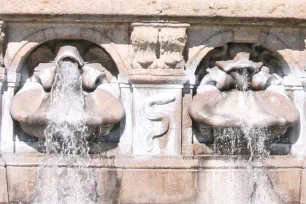The Wittelsbach Fountain is the most monumental – if not the most beautiful – fountain in Munich. The fountain was created at the end of the nineteenth century by the German sculptor Adolf von Hildebrand.


The fountain was built in 1893-1895 to commemorate the construction of Munich’s water supply system. It is named for the House of Wittelsbach, who ruled over Bavaria for more than seven centuries. The fountain is located at the north-east side of Lenbachplatz.
Von Hildebrand
After the completion of the water supply system, the local government decided to celebrate the occasion with the installation of a fountain. A competition was organized, but none of the entrants’ submissions were deemed satisfactory by the jury and a new competition was announced. Von Hildebrand, who was a member of the jury, resigned and decided to enter the second competition himself.


Von Hildebrand’s monumental design with large sculptures was unanimously selected as the winner. At the time von Hildebrand was already an acclaimed artist, who had spent several years in Florence, and his design shows his classicist roots.
The Fountain
Water cascades from a central bowl into a large basin. The bowl is flanked by two marble statues, allegorical figures that symbolize the positive and negative aspects of water.
The statue of a young man throwing a stone while mounted on a restive seahorse symbolizes the destructive power of water. The statue on the other side of the fountain – a water nymph, sitting on a bull and holding a goblet – represents the beneficial power of water. The base of the basin is decorated with a series of water spouting fish.
- Next: Olympiapark
- More Sights & Attractions in Munich

